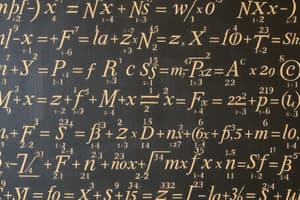Podcast
Questions and Answers
What is one of the primary purposes of mathematical symbols?
What is one of the primary purposes of mathematical symbols?
- To rely solely on verbal explanations
- To confuse learners with different representations
- To create complexity in mathematics
- To represent concepts and operations clearly (correct)
Why are mathematical symbols important across different cultures?
Why are mathematical symbols important across different cultures?
- They complicate mathematical communication
- They allow for universal understanding of concepts (correct)
- They replace the need for numbers
- They are only used in specific regions
Which of the following symbols is used for equality?
Which of the following symbols is used for equality?
- >=
- !=
- <
- = (correct)
What type of relationship does the symbol '>' represent?
What type of relationship does the symbol '>' represent?
Which of the following best describes mathematical symbols?
Which of the following best describes mathematical symbols?
Flashcards
Mathematical Symbols
Mathematical Symbols
Mathematical symbols are special characters used to represent concepts, operations, and relationships in math.
Universal Understanding
Universal Understanding
They let everyone understand math concepts, regardless of their language or background.
Equality Symbol
Equality Symbol
The symbol '=' indicates that two things are equal in value.
Inequality Symbols
Inequality Symbols
Signup and view all the flashcards
Conciseness and Clarity
Conciseness and Clarity
Signup and view all the flashcards
Study Notes
Mathematical Symbols
- Mathematical symbols represent concepts, operations, and relationships concisely and unambiguously.
- Symbols facilitate universal understanding of mathematical concepts across languages and cultures.
- Common symbols include equality (=), inequality (>, <, ≠), and arithmetic operations (+, -, ×, ÷).
- More complex mathematical concepts use specialized symbols, such as integrals (∫), derivatives (d/dx), and summation (Σ).
- Mathematical symbols are integral in representing fundamental notions, aiding problem-solving and proving theorems.
Mathematical Language
- Mathematical language employs precise terminology to define concepts and relationships.
- Precision is vital for clarity; ambiguity has no place in mathematics.
- Mathematical language is essential for constructing arguments; it formulates hypotheses, describes properties, and proves conclusions rigorously.
- Key mathematical language includes "if," "then," "and," "or," "for all," and "there exists," each possessing precise logical meanings. These are crucial for expressing logical relationships, like proofs by implication, and universal and existential quantifications.
- Mathematical terminology evolves reflecting field advancements, but its core remains grounded in formal logical structures.
- Mathematical symbolism supports the language by providing unambiguous notations, enhancing the rigor, conciseness, and clarity of communication.
- Mathematical languages differ from regular languages by their ability to precisely describe abstract concepts and relationships, essential for theoretical models and problem-solving.
- Mathematical symbols and language are fundamental for mathematical reasoning, proof construction, and result communication, fostering a common understanding, and driving progress in the field.
Relationship between Symbols and Language
- Mathematical symbols and language are interconnected, with symbols often representing concepts defined in the mathematical language.
- The symbol "∫" represents the definite integral, defined by rules articulated in the mathematical language.
- The precise meaning of a mathematical symbol stems directly from its definition within the mathematical language.
- The language facilitates the interpretation of symbols in context with specific problems or arguments.
- Mathematical language and symbols are crucial for communication, understanding, and development of mathematical concepts and their applications.
Studying That Suits You
Use AI to generate personalized quizzes and flashcards to suit your learning preferences.



